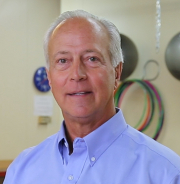All PGA instructors agree and are well aware of the importance of shoulder rotation in the golf swing. It is often a difficult concept to convey because many golfers are not very flexible in their shoulders. Mobility of the shoulders is frequently inhibited by anterior and posterior muscular imbalances. Muscles in the anterior (front) of the shoulder are usually tight and pull the shoulders forward. To accommodate the shoulders rounding forward the muscles in the posterior (back) of the shoulder deactivate, overstretch and weaken. Daily physical demands, age, posture, and genetics will determine the probability and extent of symptoms developing. Shoulders that roll forward result in a decrease in swing width. The golfer's ability to open up the chest and externally rotate the shoulders throughout the golf swing is compromised. Swing speed, rhythm, and timing are consistently challenged.
Clinically shoulder rotation involves more than your shoulders and arms. The mid-back (thoracic spine) has to be involved to maximize your shoulder turn. Whether the thoracic spine is engaged in the initial aspects of the swing, during the swing blending with hip rotation, or at the end of the back swing, it must participate in your shoulder turn. Without thoracic spine rotation the ability to maintain posture and swing plane is compromised from a clinical perspective. Your ability to build potential energy in your body (coiling) is directly related to how you utilize your thoracic spine during your swing. Trying to coil the torso and increase the "X Factor" with only the arms and shoulders will severely limit your golf capabilities. Deficiencies in shoulder function can benefit from utilizing the mobility of the thoracic spine. In fact, the probability of shoulder injury is decreased if the mid back is mobile and flexible.
Typically the mid back is under utilized in many rotary sports such as golf, tennis, baseball and hockey. In amateur athletes this occurs for three reasons: 1) unawareness of the thoracic spine's capability, 2) being overweight (thoracic spine curve increases, ie "hunchback posture" and rib mobility decreases) and 3) programmed forward body posture from the daily demands of working over a desk on the computer or being in a stooped position working all day.
The number one reason of thoracic spine underutilization is taken care of since you have read this blog and are now aware of how the mid back is involved in shoulder rotation. The second reason can be addressed by consulting a health care specialist or an organization that addresses dietary and specific eating considerations and challenges. The third reason involving poor posture can be addressed with simple exercises that are to be done on a daily basis. Stretching the front of the shoulder in an open doorway or against a wall for 30 seconds then squeezing the shoulder blades together for 10 seconds and doing it 2-3 times per day is a good start. Doing T, Y, and W's while making sure that you squeeze the shoulder blades together before the motion is started or at the end of the motion will activate stabilizing muscles in the mid back.
The instruction given by PGA Professionals is necessary and invaluable to all golfers. Blending technical information with the concepts of clinical movement patterns enhances the capabilities of all golfers. The result is enhanced performance and further enjoyment for the golfer!

